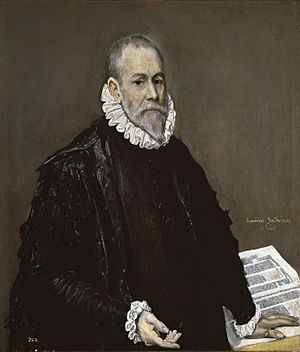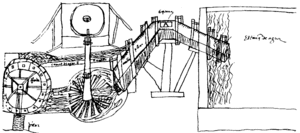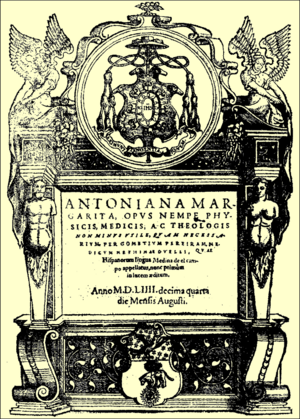Gómez Pereira facts for kids
Quick facts for kids
Gómez Pereira
|
|
|---|---|
 |
|
| Born | 1500 |
| Died | 1567 |
| Occupation | Doctor, philosopher |
Gómez Pereira (1500–1567) was an important Spanish philosopher and doctor from Medina del Campo. He worked hard to update medical ideas from the Middle Ages and suggested using scientific methods based on observation and experience. His philosophical ideas were very advanced and are seen as an early version of what René Descartes later wrote. Pereira was actually the first to write a famous phrase similar to "I think, therefore I am" in 1554, which is often mistakenly given to Descartes. He was well-known for his medical skills, but he also had many other jobs, like running businesses, engineering, and studying philosophy.
Contents
Biography
We don't know a lot about Gómez Pereira's life because his personal writings weren't saved. What we do know comes from old business papers and legal documents that researchers have put together.
Gómez Pereira was born in 1500 in Medina del Campo. He was the second of five brothers. His father, Antonia Pereira, owned a small shop selling fabrics. His mother, Margarita de Medina, passed away in 1515. After her death, his aunt Ana de Avila took care of the children. Some people believe Pereira's family might have originally come from Portugal and converted to Christianity, but this isn't fully proven.
Pereira studied philosophy at the University of Salamanca. His professor was Juan Martínez Silíceo, who later became an important archbishop. At the university, Pereira preferred learning through experience and reason, rather than just following old teachings. He also studied medicine there and finished his studies in 1520.
After university, he returned to Medina del Campo and became a doctor. He married Isabel Rodriguez and lived on Rúa Nueva (now Padilla Street). Besides being a doctor, he managed family businesses. He was quite wealthy and invested in many things, like collecting income for churches, trading wines, and renting rooms to merchants during the "Great Exhibitions of the Kingdom" in Medina.
His reputation as a doctor grew beyond Medina. He practiced in other big cities like Burgos, Segovia, and Ávila. He even treated Prince Charles, the heir to the throne, who had a serious accident. Thanks to Pereira, the Prince survived for several more years. Pereira was also interested in building machines that used water. With his friend Francisco Lobato, he designed a special watermill dam in 1563.
This special mill was designed for King Maximilian II of Austria. The king wanted to travel up the Douro River and ordered that anything blocking the river, like fishing spots or mills, be removed. This caused problems for local people. So, Lobato and Pereira designed a mill that could grind grain using water power without being directly on the riverbank. They tested a model, but it used too much water. Even though they improved the design, the king lost interest, and the project was forgotten.
Pereira's unique ideas came from combining philosophy and medicine. He didn't just accept the old ideas from ancient and medieval thinkers. Instead, he relied on reason, logic, and his own experiences. He often used puzzles and logical arguments to show where old ideas were wrong.
Novae veraeque Medicinae
Novae veraeque Medicinae (which means "New and True Medicine") is a medical book by Pereira. It mainly discusses fevers, their causes, and different types. It also covers diseases like leprosy and smallpox. In this book, Pereira challenged the traditional medical ideas of Aristotle and Galen, as well as the medieval idea of simply believing what a master said.
Pereira's method was based entirely on observation and reason, using his experience as a doctor. He believed that healing methods should be simple. He thought that a doctor's experience and method were the best way to find the truth in medicine.
Gómez Pereira believed that the heat from a fever is the body's way of fighting off illness and restoring its natural balance. This was a very modern idea for his time, seeing fever as a helpful reaction against disease. Later, other doctors praised his studies on diseases like leprosy and smallpox.
Antoniana Margarita
Antoniana Margarita was reprinted many times, but it was only translated into Spanish recently (in 2000) from its original Latin. Pereira dedicated this work to his teacher Juan Martínez Siliceo. It was also a tribute to his parents, Antonio and Margarita. The book's subtitle clearly shows its scientific and philosophical content, saying it's useful for doctors, scientists, and theologians.
This book can be difficult to read because it doesn't have clear chapters or paragraphs. It explores new ideas about learning through experience and the nature of reality. Pereira used a special way of writing, perhaps to make his potentially controversial ideas less obvious during a time when religious authorities were very strict.
The book discusses three main topics:
- How animals behave automatically.
- How humans gain knowledge.
- The idea that the human soul lives forever.
The insensibility of animals
Pereira believed that animals are not the same as humans, even though they share some similarities. Both have bodies with five senses. However, Pereira argued that for animals, their senses don't lead to true understanding. Instead, they cause automatic reactions. Animals can act on their own urges, respond to outside signals, and even learn a bit without being truly aware. But Pereira stated that animals don't have real knowledge.
Many people supported this idea because, as Pereira pointed out, if animals felt exactly like humans, there would be no difference between them. This would seem strange and wrong to many at the time. However, some people disagreed, including other doctors.
Human knowledge
Pereira's ideas about human knowledge were very different from the common medieval teachings. He believed that knowledge first enters through our senses, just like in animals. But he argued that only the human soul, or spirit, can turn this sensory information into real thoughts. This ability to take the main idea from physical sensations is a special quality of the soul. Pereira thought that feeling and thinking are closely linked in humans. He famously said, "if you feel, you understand."
The immortality of the soul
Pereira believed that knowledge is a key part of the soul. He also thought that humans have a soul that is aware of itself and exists because of the thoughts it creates. In his book Antoniana Margarita, he wrote a phrase similar to "I know that I know something, and whatever knows exists, therefore I exist."
Even though Pereira wrote this in 1554, his contribution wasn't widely recognized for a long time. Later, René Descartes was even accused of copying this idea from Pereira.
Pereira did believe that animals have souls, but he thought these souls die with their bodies. The human soul, however, he argued, is self-sufficient and therefore lives forever. He offered three reasons for this. First, because the human soul is conscious, it can know things independently of the body, meaning it can exist even after the body dies. Second, the human soul doesn't change even if the body gets old or sick; its true nature isn't affected. Third, all humans want to be happy and know what will happen in the future, which encourages us to do good deeds, as bad actions lead to unhappiness.
Pereira and Descartes
After René Descartes published his famous book Discourse on Method in 1637, people started to question if his ideas were truly original. Some even said he had copied from Gómez Pereira, whose work was studied by many smart people in the 1500s and 1600s.
One of the first people to point out the similarities was Pierre Daniel Huet. Descartes himself had to defend his ideas against these claims. He wrote a letter in 1641 to his friend Father Marin Mersenne, explaining his side.
Many scholars in the 1600s and 1700s supported Descartes and didn't think Pereira's work was as important. However, many others argued the opposite. They believed that even if Descartes hadn't directly read Pereira's book, he might have been influenced indirectly. Some people who accused Descartes of copying included Isaac Cardoso and Voltaire.
The main reasons for these accusations are the striking similarities between the two thinkers on several key points:
- The method of learning: Descartes' method started with ideas and used logic, while Pereira's method started with observations and used reasoning from those observations.
- Souls of animals: Both believed that animal souls were physical, limited, and died with the body.
- Animals acting automatically: Descartes said animals have a body, mind, and memory. Pereira said something similar, explaining that animals have an internal structure, react to outside signals, and can learn.
- The basic idea of existence: The famous "I think, therefore I am" from Descartes is very similar to Pereira's "whatever knows, exists, therefore I exist." Pereira wrote his idea about 100 years before Descartes.
Images for kids
See also
In Spanish: Gómez Pereira para niños




